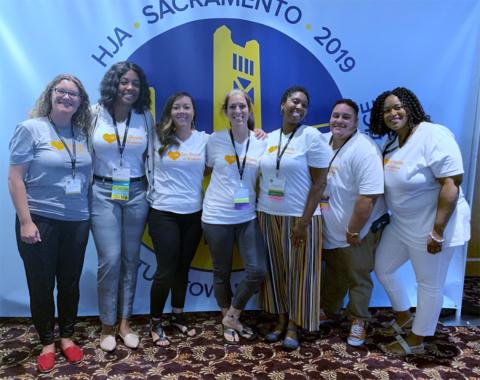Ranney Advocates Public Health Approach to Prevent Gun Violence

Stories of gun violence blanket the news almost daily. As deaths and injuries from firearms continue to climb, potential solutions often get stymied by a politically charged climate. NIH-funded researchers are collaborating on a range of interventions to address the pervasive problem of violence.
Dr. Megan Ranney regularly sees the effects of violence firsthand as an emergency department (ED) physician. “I take care of victims of violence every day on every shift,” said Ranney, incoming dean of Yale School of Public Health, who spoke at a recent seminar hosted by NIH’s Office of Behavioral and Social Sciences Research. “As a health care provider, I’m deeply aware of the ways in which our country’s epidemic of violence affects us.”
Beyond a Criminal Justice or Legislative Problem
Violence skews by gender and race. Gun violence is most common among men. Minority populations, particularly Black men, are 20 times more likely to be victims of firearm homicide, while White and American Indian/Alaskan Native men are more likely to die of firearm suicide.
There are approximately 400 million firearms in private hands across the country and about 45,000 gun deaths each year. Over the past two decades, the number of firearm deaths has steadily risen and, currently, is the highest it’s been since its peak in the early 1990s.
The reality is, “We cannot wish away those 400 million firearms,” said Ranney. She advocates instead for applying a public health approach to counter gun violence.
The four-step public health plan—one that has proven effective in dramatically reducing deaths from other epidemics such as car crashes and HIV/AIDS—involves gathering data to measure incidence; identifying risk and protective factors; developing and testing interventions; and implementing what works. Within this model, specific strategies can be tailored for individuals or groups and can encompass relationships, neighborhoods and society as a whole.
“The reason we have not seen success [in reducing gun violence] is because we have not applied this public health approach for a variety of reasons, including politicization and lack of funding,” she said, “and most of all, this lack of realization that violence is inherently a public health problem.”
The reality is, “We cannot wish away those 400 million firearms.”
But gun violence cannot be studied or addressed in a vacuum. It co-occurs with overlapping epidemics, or “syndemics.”
One syndemic that often envelops the gun violence debate is the growing rate of mental health disorders, including a troubling rise in depression among youth and young adults over the past two decades. The link between violence and mental health issues is complex.
“We want to call people who commit mass shootings crazy or mentally ill,” said Ranney. Some have had mental health problems and were in crisis prior to the shooting. “But what we find is that one of the biggest correlates of being a mass shooter is actually a prior criminal history, particularly a prior history of domestic violence,” she said. Often, there were missed warnings signs.
Meanwhile, two-thirds of firearm deaths in this country are suicides. But, Ranney noted, mental illness treatment alone may not be sufficient to decrease suicide. Access to lethal means—like firearms—is also a big factor, and firearm suicide rates are higher in states where more people have access to a firearm at a moment of despair.
Another intersecting epidemic is the substance abuse and opioid crisis.“We cannot separate out our country’s epidemic of violence, particularly firearm violence, from the other epidemics also occurring,” Ranney cautioned. “Unfortunately, by the time the trigger is pulled, we’ve missed upstream opportunities for prevention.” As an emergency physician and researcher, she is gathering data, identifying risk and protective factors and working on effective interventions.
Toward Digital Health Solutions

Ranney, the founding director of the Brown-Lifespan Center for Digital Health, is developing and testing digital health interventions toward preventing violence and related behavioral health problems.
A project called iDOVE2—funded by the National Institute of Child Health and Human Development (NICHD)—aims to break the cycle of peer violence and depressive symptoms among at-risk adolescents.
Some 40% of adolescents who come through EDs for any reason report they have been in a physical fight in the past year. These kids are at higher risk for future physical fights, firearm injury and behavioral health problems, noted Ranney.
The project delivers a brief intervention by a trained researcher and follows up with an automated text-messaging program that provides conflict resolution and cognitive and behavioral therapeutic (CBT) skills. The pilot study showed improved depressive symptoms and reduced physical violence among the most symptomatic youth. Based on this success, an 800-person randomized trial is underway that includes live interactions with a counselor.

Another similar project, partly funded by NICHD, works with youth who are victims of cyberbullying. An automated app offers CBT and other support. Unfortunately, the pandemic interrupted the study at the four-month mark.
“The fact that I saw improved well-being and stress among the kids that participated in the intervention despite that, by that point, many, if not all, of these kids were out of in-person school was remarkable and highlights the fact that we can get at these syndemics using relatively low-tech, low-touch tools,” Ranney said.

Other studies are targeting the larger community. Guardians 4Health is a Centers for Disease Control and Prevention (CDC)-funded study in partnership with Brown University—where Ranney was deputy dean of its school of public health before arriving at Yale—and 4-H Shooting Sports. The study enrolls children nationwide to partner with 4-H in teaching “bystander intervention” techniques for all aspects of firearm injury prevention, ranging from safer storage to recognizing suicide risks.
“There’s this larger perspective of how to empower these youth to be aware of risk factors for intentional firearm injury to help communities recognize risk and act on it,” Ranney said.
Another NICHD-supported study, which she’s conducting with her colleague Dr. Nicole Nugent, examines yet another driver of these syndemics—loneliness and increased social isolation. The project, which is enrolling youth in the ED, is monitoring connections among violence, loneliness and social media use.
Ranney described other NIH- and CDC-funded research looking at such topics as safer storage of firearms in the home, particularly how to protect people with dementia, mental health challenges, visiting grandkids or others at imminent risk.
Ranney also highlighted violence intervention programs spearheaded by her colleagues. Many of these community- and hospital-based programs seek to address structural racism and economic disempowerment which, she said, “leads kids—particularly Black and Brown youth—to end up in the emergency department as victims of an assault, shooting or stabbing.”
As research continues toward finding optimal strategies that prevent firearm injuries and deaths, Ranney offered a stark reminder of the ubiquity of this problem.
“None of us are immune,” she said. “As we talk about addressing this syndemic as researchers, it’s important to remember the degree to which this affects so many within our community. We should be so lucky as to not have it touch our own family.”
